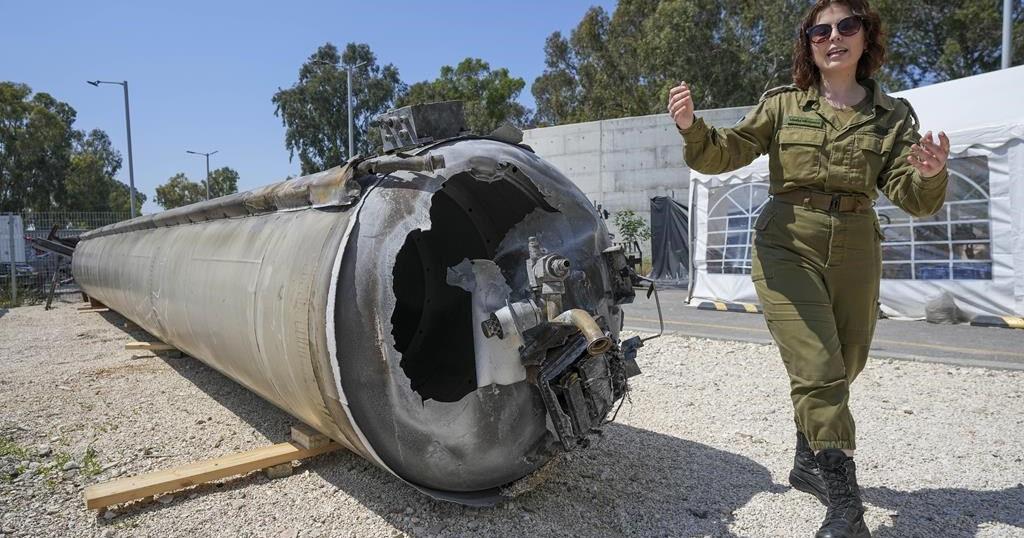DUBAI, United Arab Emirates (AP) — As Iran threatens to attack Israel over the assassination of a Hamas leader in the Iranian capital, its long-vaunted missile program offers one of the few ways for Tehran to strike back directly, but questions loom over just how much of a danger it poses.
The program was behind Iran’s unprecedented drone-and-missile assault on Israel in April, when Iran became the first nation to launch such a barrage since Iraqi dictator Saddam Hussein lobbed Scud missiles at Israel in the 1991 Gulf War.
But few of the Iranian projectiles reached their targets. Many were shot down by a U.S.-led coalition, while others apparently failed at launch or crashed while in flight. Even those that reached Israel appeared to miss their marks.
Now a new report by experts shared exclusively with The Associated Press suggests one of Tehran’s most advanced missiles is far less accurate than previously thought.
The April assault showed “some ability to strike Israel,” said Sam Lair, a research associate at the James Martin Center for Nonproliferation Studies who worked on the analysis. But “if I were supreme leader, I would probably be a little disappointed.”
If Iranian missiles are not able to hit targets precisely “that recasts their role,” Lair added. “They’re no longer as valuable for conducting conventional military operations. They may be more valuable simply as terror weapons.”
As an example, he recalled the harassing missile fire seen on cities in the Iran-Iraq war in the 1980s, when Iran could fire a variety of missiles at a large city and hope some got through.
Iran has repeatedly said it will retaliate for the killing of Ismail Haniyeh. Israel is widely suspected of carrying out the assassination, though it has not claimed it.
The Iranian mission to the United Nations did not respond to a request for comment. But Supreme Leader Ayatollah Ali Khamenei tacitly acknowledged the country’s failure to strike anything of importance in Israel.
“Debates by the other party about how many missiles were fired, how many of them hit the target and how many didn’t, these are of secondary importance,” Khamenei said. “The main issue is the emergence of the Iranian nation” and the Iranian military “in an important international arena. This is what matters.”
A fusillade of missiles and drones
Retaliation had been expected for days after a suspected Israeli strike on April 1 hit an Iranian diplomatic compound in Damascus, Syria, killing two Iranian generals and five officers, as well as a member of the Lebanese Shiite militia Hezbollah.
Footage aired on state television showed that Iran’s April 13 assault began with Revolutionary Guard commander Gen. Hossein Salami speaking by telephone with Brig. Gen. Amir Ali Hajizadeh, the commander of the Guard’s aerospace division.
“Start the ‘True Promise’ operation against Zionist regime’s bases,” he ordered.
As the missiles headed skyward, people across Iran stopped what they were doing and pointed their mobile phones at the launch noise from their cars and the balconies of their homes. Videos analyzed by the AP showed multiple launch sites, including on the outskirts of Arak, Hamadan, Isfahan, Kermanshah, Shiraz, Tabriz and Tehran.
Grainy footage later released through pro-Iranian military social media accounts showed missiles thundering off truck-based mobile launchers. Iran’s bomb-carrying Shahed drones, widely used by Russia in its war on Ukraine, leaped off metal stands, their engines whirring like lawnmowers through the night sky. Some were launched by pickup trucks racing down runways.
The triangle-shaped drones went first, taking hours to reach their targets. Then came the Paveh cruise missiles, taking a shorter time, and finally the Emad, Ghadr and Kheibar Shekan ballistic missiles, which needed only minutes, according to an analysis by the Wisconsin Project on Nuclear Arms Control. Drones and missiles also came from Yemen, likely fired by the Iranian-backed Houthi rebels.
Israeli officials estimated that Iran launched 170 drones, 30 cruise missiles and 120 ballistic missiles. In Jordan, an AP journalist filmed what appeared to be a ballistic missile being intercepted above the Earth’s atmosphere, likely by an Israeli Arrow 3 missile, with the blast radiating out like a circle.
The U.S., the United Kingdom, France and Jordan all shot down incoming fire. The Americans claimed to have downed 80 bomb-carrying drones and at least six ballistic missiles. Israeli missile defenses were also activated, though their initial claim of intercepting 99% of the projectiles appeared to be an exaggeration.
The attack “was very clearly not something symbolic and not something trying to avoid damage,” said Fabian Hinz, a missile expert and research fellow at the International Institute for Strategic Studies who studies Iran. It was “a major attempt to overcome Israeli defenses.”
U.S. officials, who spoke on condition of anonymity to discuss intelligence matters, told the AP they assessed that 50% of the Iranian missiles failed at launch or crashed before reaching their target.
Strike on air base
suggests poor accuracy
In the aftermath, analysts at the James Martin Center for Nonproliferation Studies examined the strike on the Nevatim Air Base some 65 kilometers (40 miles) south of Jerusalem in the Negev Desert. The center’s experts long have studied Iran and its ballistic missile program.
The base came into immediate focus after the suspected Israeli strike on the Iranian diplomatic mission in Syria. Iran’s ambassador to Syria, Hossein Akbari, claimed that the strike was conducted by Israeli F-35Is, which are based at Nevatim.
The air base also figured into Iranian military propaganda. Iranian state television aired footage in February of a Revolutionary Guard test that targeted a mock-up resembling F-35I hangars at Nevatim. Ballistic missiles, including some of the kinds used in the April attack on Israel, destroyed the mock-up.
In the attack, at least four Iranian missiles struck Nevatim, as seen in satellite images and footage released by the Israeli military.
The only debris found in the area — collected from the Dead Sea — suggests Iran used Emad missiles to target Nevatim, the analysts said. The liquid-fueled Emad, or “pillar” in Farsi, is a variant of Iran’s Shahab-3 missile built from a North Korean design with a reported range of 2,000 kilometers (1,240 miles). That indicates the Emads were likely fired from the Shiraz area, which is within the estimated limits of the missile’s likely capabilities, the analysts said.
Based on Iran’s focus on the F-35I, the James Martin analysts assumed the likely target point for the Iranian fire would be a cluster of aircraft hangars. The position also serves as a near-central point within the Nevatim base itself.
That offers “a much more valuable target” than just “poking holes in the runway,” Lair said. But none of the Iranian missiles directly hit those hangars.
Assuming Iran targeted the hangars, the James Martin analysts measured the distance between the hangars and the impact zones of the missiles. That gave an average of about 1.2 kilometers (0.75 miles) for the “circular error probable” — a measurement used by experts to determine a weapon’s accuracy based on the radius of a circle that encompasses 50% of where the missiles landed.
That’s far worse than a 500-meter (1,640-foot) error circle first estimated by experts for the Emad. After a U.N. weapons ban on Iran ended in 2020, Iran separately advertised the Emad to potential international buyers as having a 50-meter (164-foot) circle — a figure that is in line with top missile specifications for systems deployed elsewhere, said Hinz, the IISS missile expert.
The results from April’s attack were nowhere near that precise.
“This means the Emad is much less accurate than previous estimates indicated,” Lair said. “This indicates the Iranians are a generation behind where previous assessments thought they were in accuracy.”
The poor performance may be attributable to electronic warfare measures designed to confuse the missile’s guidance system, as well as potential sabotage, poor missile design and the distances involved in the attack.
What’s next
In the past, Iranian threats to retaliate against Israel generally took the form of either attacks by Iranian-backed forces in the Mideast or assaults aimed at Israeli targets elsewhere, such as embassies or tourists aboard.
Geography limits the options for a direct Iranian military attack. Iran shares no border with Israel, and the two countries are some 1,000 kilometers (620 miles) apart at the shortest distance.
Iran’s air force has an aging fleet led by F-14 Tomcats and Mikoyan MiG-29 fighter jets from the Cold War, but they would be no match for Israel’s F-35Is and its air defenses. That means Iran again would need to rely on missiles and long-range drones.
It could also enlist help from allied militias such as Lebanon’s Hezbollah and Yemen’s Houthi rebels to overwhelm Israel’s defenses. Israel and Hezbollah exchanged heavy fire on Aug. 25.
Always present in the background is the risk that Tehran could develop a nuclear weapon, a threat that Iranian officials have repeated in recent months. While Iran insists its nuclear program is peaceful, Western intelligence agencies and the International Atomic Energy Agency say Tehran had an organized military nuclear program until 2003.
U.S. intelligence agencies said in a report in July that Iran has “undertaken activities that better position it to produce a nuclear device, if it chooses to do so.” However, building a weapon and miniaturizing it to put on a ballistic missile could take years.
“Iran has the largest inventory of ballistic missiles in the region and continues to emphasize improving the accuracy, lethality and reliability of these systems,” the report from the director of national intelligence said. “Iran probably is incorporating lessons learned” from the April attack.
___
Associated Press writers Lolita C. Baldor in Washington and Nasser Karimi and Amir Vahdat in Tehran, Iran, contributed to this report.
___
The Associated Press receives support for nuclear security coverage from the Carnegie Corporation of New York and Outrider Foundation. The AP is solely responsible for all content.

























